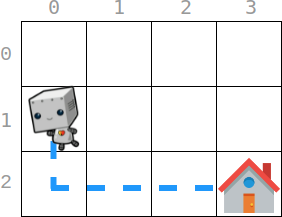- {x}
- Watering Plants
- Range Frequency Queries
- Sum of k-Mirror Numbers
- The Number of Rich Customers
- Substrings That Begin and End With the Same Letter
- Drop Type 1 Orders for Customers With Type 0 Orders
- Count Common Words With One Occurrence
- Minimum Number of Food Buckets to Feed the Hamsters
- Minimum Cost Homecoming of a Robot in a Grid
- Count Fertile Pyramids in a Land
- Find Target Indices After Sorting Array
- K Radius Subarray Averages
- Removing Minimum and Maximum From Array
- Find All People With Secret
- Minimum Cost to Reach City With Discounts
- Finding 3-Digit Even Numbers
- Delete the Middle Node of a Linked List
- Read More...

Minimum Cost Homecoming of a Robot in a Grid
There is an m x n grid, where (0, 0) is the top-left cell and (m - 1, n - 1) is the bottom-right cell. You are given an integer array startPos where startPos = [startrow, startcol] indicates that initially, a robot is at the cell (startrow, startcol). You are also given an integer array homePos where homePos = [homerow, homecol] indicates that its home is at the cell (homerow, homecol).
The robot needs to go to its home. It can move one cell in four directions: left, right, up, or down, and it can not move outside the boundary. Every move incurs some cost. You are further given two 0-indexed integer arrays: rowCosts of length m and colCosts of length n.
- If the robot moves up or down into a cell whose row is
r, then this move costsrowCosts[r]. - If the robot moves left or right into a cell whose column is
c, then this move costscolCosts[c].
Return the minimum total cost for this robot to return home.
Example 1:

Input: startPos = [1, 0], homePos = [2, 3], rowCosts = [5, 4, 3], colCosts = [8, 2, 6, 7] Output: 18 Explanation: One optimal path is that: Starting from (1, 0) -> It goes down to (2, 0). This move costs rowCosts[2] = 3. -> It goes right to (2, 1). This move costs colCosts[1] = 2. -> It goes right to (2, 2). This move costs colCosts[2] = 6. -> It goes right to (2, 3). This move costs colCosts[3] = 7. The total cost is 3 + 2 + 6 + 7 = 18
Example 2:
Input: startPos = [0, 0], homePos = [0, 0], rowCosts = [5], colCosts = [26] Output: 0 Explanation: The robot is already at its home. Since no moves occur, the total cost is 0.
Constraints:
m == rowCosts.lengthn == colCosts.length1 <= m, n <= 1050 <= rowCosts[r], colCosts[c] <= 104startPos.length == 2homePos.length == 20 <= startrow, homerow < m0 <= startcol, homecol < n
Solution Explanation for Minimum Cost Homecoming of a Robot in a Grid
This problem involves finding the minimum cost for a robot to travel from a starting position to its home position in a grid. The robot can move up, down, left, or right, with the cost of each move depending on the row or column.
Approach:
The optimal approach is a greedy one. Since the cost of moving in a row or column only depends on the row or column index, respectively, the most efficient way to reach the home position is to move directly to it along the rows and then along the columns (or vice versa). This avoids unnecessary detours. We calculate the cost of moving in each direction separately and sum them up to get the total minimum cost.
Algorithm:
- Initialize: Start with a total cost
ansinitialized to 0. - Row Movement: Calculate the cost of moving from the starting row to the home row.
- If the starting row is less than the home row, iterate through
rowCostsfromstartRow + 1tohomeRow(inclusive) and add each cost toans. - If the starting row is greater than the home row, iterate through
rowCostsfromhomeRowtostartRow(inclusive) and add each cost toans.
- If the starting row is less than the home row, iterate through
- Column Movement: Calculate the cost of moving from the starting column to the home column.
- If the starting column is less than the home column, iterate through
colCostsfromstartCol + 1tohomeCol(inclusive) and add each cost toans. - If the starting column is greater than the home column, iterate through
colCostsfromhomeColtostartCol(inclusive) and add each cost toans.
- If the starting column is less than the home column, iterate through
- Return: Return the final calculated
ansas the minimum total cost.
Time and Space Complexity:
- Time Complexity: O(m + n), where m is the number of rows and n is the number of columns. This is because we iterate through at most the entire
rowCostsarray and the entirecolCostsarray once. - Space Complexity: O(1). The algorithm uses only a constant amount of extra space to store variables.
Code Implementation:
The code implementations in Python, Java, C++, and Go follow the algorithm described above. The Python and C++ versions use the sum() function to efficiently add up the elements of the relevant slices of the cost arrays. The Go version uses a helper function sum to achieve the same. The Java version iterates explicitly. All versions achieve the same optimal time complexity.
Example (Python):
class Solution:
def minCost(
self,
startPos: List[int],
homePos: List[int],
rowCosts: List[int],
colCosts: List[int],
) -> int:
startRow, startCol = startPos
homeRow, homeCol = homePos
ans = 0
if startRow < homeRow:
ans += sum(rowCosts[startRow + 1:homeRow + 1])
else:
ans += sum(rowCosts[homeRow:startRow])
if startCol < homeCol:
ans += sum(colCosts[startCol + 1:homeCol + 1])
else:
ans += sum(colCosts[homeCol:startCol])
return ans
The other languages have similar implementations, reflecting the same algorithm with minor syntactic differences. The choice of language does not impact the fundamental time or space complexity.